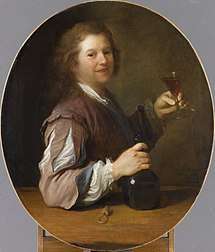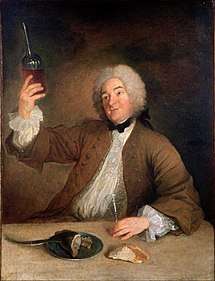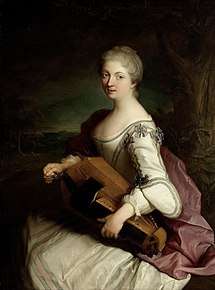Alexis Grimou
Alexis Grimou, also Grimoult or Grimoux (1678-1733) was a French portrait painter.[2] He worked for an elite clientele and was called the French Rembrandt as he introduced the Northern European style of portrait painting in France.[3] Many of his intimate portraits at half-lengths were influential on the development of 18th century portrait painting in France. Portrait painters such as Jean-Honoré Fragonard, and Jean-Baptiste Greuze were influenced by his work.[4]
Alexis Grimou | |
|---|---|
 Self-portrait as a drinker (1724) | |
| Born | 24 May 1678 Argenteuil,[1] France |
| Died | May 1733 Paris, France |
Biography
Grimou was born in Argenteuil on 24 May 1678, the son of a carpenter. He is often confused with Jean Grimou (1674-1733), an unrelated Swiss genre painter whose father served with the Swiss Guards at Versailles.[5] Grimou probably trained with François de Troy, from whom he learnt to use a warm palette and simple pictorial compositions.[4] Sometime in the late 1690s, he was apprenticed to the painter and engraver, Bon Boullogne.[6]

In 1704, he married Marie-Gabrielle Petit, a niece of Procopio Cutò, founder of the Café Procope, a meeting place for artists and intellectuals. Economics may have been a motive in the union, as a notary document in the Archives Nationales reveals that she owned a considerable amount of property on Mauritius; along with slaves and "autres effets mobiliers et immobiliers" (other assets, moveable and immoveable).
His brother-in-law, Matthias François Petit, was the intermediary who, between 1740 and 1753, was commissioned to purchase art for the collection of King Friedrich II of Prussia. That collection would come to include numerous works by Boullogne and his students.[6].
In 1705 he was approved (agréé) by the Académie Royale. In order to be admitted as full member of the Académie he was required to paint two reception piece, being portraits of the sculptor, Jean Raon, who died before it was completed, and the painter, Antoine Coypel, whose portrait was still unfinished by 1709. As a result of his failure to present the reception piece, he was removed from the list of the Académie. He then joined the Académie de Saint-Luc instead.[4]
In 1709, he may have visited the Netherlands to copy the Dutch Masters. This is inferred from a sudden darkening in his use of color and some copies he made later. Known to have a dissolute lifestyle, he was always in debt and often paid his creditors with small works done on the spot. From 1720 until his death, for unknown reasons, he became much more responsible and productive.

He died in 1733, well known and appreciated for his painting. He was in his time referred to as a weird and strange person, in particular for his heavy drinking. According to contemporary anecdotes he also had five bottles of good Bourgogne with him while he painted.[7]. He also was said to have live a life of dissolution and poverty.[3] In 1805, he was the subject of a vaudeville entitled "Grimou ou Le portrait a finir", which was staged by Maxime de Redon in Paris.
Work
Grimou painted mainly portraits at half-length which are intimate in nature and often include a genre aspect. Because of the influence of Dutch genre and portrait painting and the use of chiaroscuro techniques similar to those used by Rembrandt in his works, he was sometimes called the "French Rembrandt". Grimou developed the moralistic traits in Dutch genre portraits into budding representations of new concept of aesthetic taste. The artist projected a refined image in his self-portraits as a drinker and as Bacchus.[3]
His fantasy portraits which are close to Dutch tronies were influential on French portrait painters in the 18th century such as Jean-Honoré Fragonard, Charles Eisen, Joseph Ducreux and Jean-Baptiste Greuze. He was so successful that he often created many variations on the same types such as that of the Young Male and Female Pilgrims which he painted as pendants.[4]
References
- Alexis Grimou – Larousse.fr
- Alexis Grimou at the RKD
- Melissa Percival, Taste and Trade: The Drinking Portraits of Alexis Grimou (1678–1733) in The Art Bulletin Volume 101, 2019 - Issue 1, pp. 6-25
- Corinne Maisant, Alexis Grimou, Grove Art online
- Cyrille Gabillot, p. 7
- François Marandet, Alexis Grimou (Argenteuil, 1678 - Paris, 1733), in: 'Dossier de presse Bon Boullogne (1649-1717) Un chef d’école au Grand Siècle', 5 décembre 2014 – 5 mars 2015 Musée Magnin, pp 20-21
- Alexis Grimou in: Mercure français, January 1777, pp. 190=197
Sources
- Cyrille Gabillot, Alexis Grimou, peintre français (1678-1733), Gazette des Beaux-Arts, Paris, 1911
- Louis Réau, "Grimou, 1678 à 1733", in Louis Dimier (Ed.), Les Peintres français du XVIIIe siècle, Vol.2, G. Van Oest, Paris, Brussels, 1930, pgs.195-215.
External links
